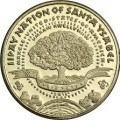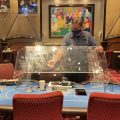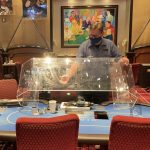
Nevada Poker Room Data Shows Peaks and Valleys for Live Rooms Over Past 24 Years

Nevada poker then and now: the 2003 World Series of Poker Main Event champ Chris Moneymaker inspired millions to test their skill at the game, and his influence on the game correlated to a prosperous period in Nevada poker, which has since dwindled somewhat. (Image: toromagazine.com)
Nevada poker data on the last 24 years of the game has been compiled by the University of Nevada Las Vegas (UNLV), and the statistics paint a vivid image of how trends and events over the past quarter century have directly impacts revenues at live tables.
UNLV’s Center for Gaming Research collected statistics for the number of poker rooms, tables, and annual revenues in the Silver State dating back to 1992. The data was pieced together from Gaming Revenue Reports published by the Nevada Gaming Control Board.
Congregated in table form, the yearly performance of Nevada poker clearly reflects the overall environment and culture of the card game. It also highlights the influence state and federal lawmakers have on gambling.
The Boom
No player revolutionized poker the way that Chris Moneymaker did in 2003. Reaching the $10,000 World Series of Poker Main Event through a $39 online PokerStars satellite qualifier, Moneymaker won the grand daddy of poker for a $2.5 million first-place prize.
In 2003, there were 58 poker rooms with 383 tables in Nevada, and overall revenue came in at $68.2 million for the game. Following Moneymaker’s historic win, poker soared the following year with 21 new rooms, 101 additional tables, and a 44.8 percent revenue increase to $98.8 million.
And the poker boom continued over the next three years, reaching an all-time high of $167.9 million in 2007.
The Bust
The 2006 passage of the Unlawful Internet Gambling Enforcement Act (UIGEA) hampered the popularity of online poker, as many of the leading platforms, including PartyPoker, ceased operations. PokerStars and Full Tilt notoriously carried on even after the law made the transmission of money over the Internet for gambling illegal, but the game as players knew it was forever changed.
The impact was felt in Nevada’s brick-and-mortar rooms as well, as revenue slowly started to erode. After five years of gains, live poker fell in 2008 by 7.29 percent, 6.54 percent in 2009, and 7.13 percent in 2010.
A plunge of 19 percent, poker revenues went from $167.9 million in 2007 to just $135.2 million in just 36 months.
While Nevada card rooms maintained status quo in terms of tables during the ensuing recession revenue slide between 2008 and 2010, the federal government’s takedown of PokerStars and Full Tilt in 2011 was a further tipping point.
The headlines directly impacted live poker in the Silver State.
104 poker rooms called Nevada home in 2011. Today, only 76 remain.















0 Comments